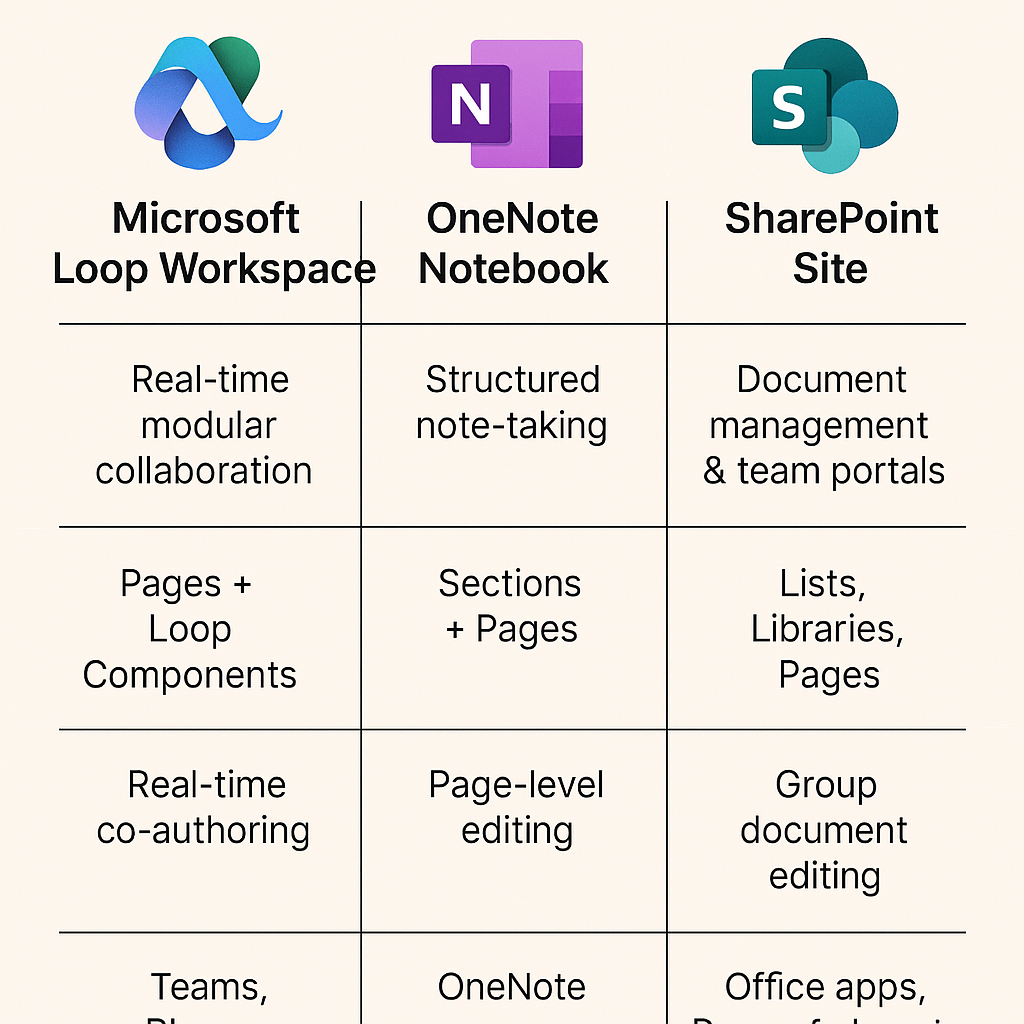In 2025, Microsoft offers Loop Workspaces, OneNote Notebooks, and SharePoint Sites as key tools for organizing information and collaboration.
While they seem similar at first glance, their core structures, collaboration models, and use cases are very different.
This guide provides a technical and practical comparison to help you pick the right tool for your team’s needs.
🔍 Quick Comparison Table
| Feature | Microsoft Loop Workspace | OneNote Notebook | SharePoint Site |
|---|---|---|---|
| Core Purpose | Real-time modular collaboration | Structured note-taking | Document management & team portals |
| Content Type | Pages + Loop Components | Sections + Pages | Lists, Libraries, Pages, Webparts |
| Real-Time Co-authoring | ✅ Native across components | ✅ But not component-based | ✅ In documents; slower in sites |
| Integration | Deep with Teams, Planner, Outlook | OneNote app + Outlook Tasks | Office apps, Lists, Power Automate |
| Offline Access | Limited (Mobile/Web sync) | Strong Offline | Depends on SharePoint sync setup |
| Versioning | Auto-versioned via OneDrive | Page versions manually managed | Full version history & recovery |
| Security Model | M365 role-based page sharing | Notebook sharing | SharePoint Site Permissions, DLP Policies |
| Best For | Agile projects, co-authoring meetings, real-time tasking | Knowledge bases, meeting notes, journals | Formal project management, intranet sites, content repositories |
🧠 How Microsoft Loop Workspaces Work
-
Built on Fluid Framework for instant sync
-
Workspace = container for Pages and Loop Components
-
Optimized for dynamic, changing work (e.g., brainstorming, agile projects)
-
Embedded across Teams chats, Outlook emails, and Word web apps
-
Designed for flexible, modular work, not strict file/document hierarchies
📒 How OneNote Notebooks Work
-
Notebook = Collection of Sections ➔ Pages ➔ Subpages
-
Structured note-taking, focused on hierarchical knowledge storage
-
Best for static or semi-structured knowledge (e.g., meeting notes, research logs)
-
Not modular: content is static per page
-
Offline-first approach: local sync on desktops and mobile devices
🏛️ How SharePoint Sites Work
-
Site = Web-based container for lists, libraries, pages
-
Optimized for document management, workflows, approvals
-
Heavy integration with Power Automate, Microsoft Lists, Office files
-
Ideal for formal team knowledge bases, intranets, business processes
-
Strict governance, metadata tagging, DLP enforcement
🔄 Practical Use Case Mapping
| Scenario | Best Tool |
|---|---|
| Agile Project Management | Microsoft Loop Workspace |
| Team Meeting Notes | OneNote Notebook |
| Corporate Policies and Document Libraries | SharePoint Site |
| Real-time Product Brainstorming | Microsoft Loop |
| Research Documentation | OneNote |
| Contract Management, Approvals | SharePoint |
⚡ Key Differentiators
| Factor | Loop | OneNote | SharePoint |
|---|---|---|---|
| Modularity | Dynamic | Static | Structured |
| AI Assistance (Copilot) | Natively integrated | Limited (dependent on Office Copilot) | Available via SharePoint Premium + Copilot |
| Automation | Power Automate triggers (emerging) | Basic task linking | Full workflows, approval chains |
| Mobile Experience | Lightweight editing | Strong offline usage | Browser + Teams app access to sites |
✅ Conclusion: When to Use Which?
-
Use Microsoft Loop when you need dynamic, fast-changing, collaborative content embedded across Teams and Outlook.
-
Use OneNote when you need structured knowledge management and offline access.
-
Use SharePoint when you need formal project portals, approval workflows, and enterprise-level governance.
Together, these tools provide a complete work management ecosystem inside Microsoft 365.
